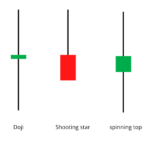Buy Call Option
In the previous chapter, we have understood the fundamentals of a call option and also the circumstances under which it should be bought. In this chapter, we will take the same thing further and try to understand how buying and selling of call options take place. But before that, let’s reiterate what we’ve learned so far:
- Buying a call option is a good option when you expect the price of the underlying to move up.
- If the underlying price stays in place or goes down, the call option buyer incurs a loss.
- The buyer of the call option suffers the same loss as the premium he has paid to the writer or seller of the call option
All three things mentioned above work as the basic principle of a call option, if you remember them then it will be easy for you to understand further things.
Preparation of Call Option
There are times when a situation arises in the market when buying a call option is a very good option. I found one such example. You see the chart below-

Here the stock of Bajaj Auto Ltd is shown. As you know it is one of the largest two-wheeler manufacturers in India. Here you can see that this stock is trading at its 52 week low, I think a trade is formed here. This is the reason for my opinion
- Bajaj Auto is fundamentally a very good stock.
- The stock has taken such a beating that I think the market has reacted too badly to the volatility in this business cycle.
- The stock has gone down a lot, I think it will not fall much from here and after that, it will go up again But I do not want to buy this stock for delivery as I am afraid that it may fall somewhere else.
- That’s why I don’t want to buy Bajaj Auto in futures also because I am afraid of M2M losses
But I also don’t want to miss the opportunity of the boom that is coming.
So overall I am very bullish on Bajaj Auto stock, but not sure if the rally will start right now or after some more downside. My uncertainty is because even a very short period downturn in this market can do big losses. As per my assessment, the chances of loss are slim but there is a possibility. So what should I do?
My dilemma is the same as Ajay’s (in the example of Ajay Venu in Chapter 1). In such a situation, options trading is a great option.
In this dilemma, buying a call option would be the best option for me. But first, let’s take a look at the option chain of Bajaj Auto-

As you can see the stock is trading at ₹2026.9 (highlighted in blue). I want to buy a call option with strike 2050, for which I have to pay a premium of ₹6.35 (shown with a red arrow in the red box). You must be wondering why I chose the strike price of 2050 when there are so many options available to me. Choosing a strike price is a separate topic in itself, which needs to be understood more. We will go through this more in the next module but for now, just understand that 2050 is the right strike price for this trade.
Intrinsic Value of Call Option at Expiry
The expiry of this call option is after 15 days. So what will happen to this call option during this period? By now you have come to know that there can be three situations here.
Scenario 1 – The stock price moves above the strike price, say by 2080
Scenario 2 – The stock price moves below the strike price, say by 2030
Scenario 3 – The stock price stays the same at 2050
The above three positions are similar to the ones we discussed in Chapter 1, so I hope you can calculate their P&L at different spot prices.
Now here we discuss a different thing-
You agree that there are only three situations where the price of Bajaj Auto Shares changes, the stock will either rise, fall or remain stable at the same price.
But how to understand the impact of other different prices in the meantime? For example, if take position 1, in this we have assumed the share price to be 2080 i.e. above the strike price of 2050. But what if the share price is 2055, 2060, 2065, 2070, or 2075 instead of 2080? So, can we deduce some signals from the P&L that prove to be true at all costs?
Similarly, in case 2, the stock price has been talked about reaching 2030, but there are also different prices like 2045, 2040, 2035 that will come in between. So, what can be said in general about the P&L formed on expiry?
What will the P&L be like at different prices in the spot on the day of expiry and what will they have in common? These different prices are what I call the likely prices to arrive in the spot upon expiry. Now through these let me generalize the P&L so that the call option can be understood.
To do this, I need to understand the principle of the intrinsic value of an option. Although we will not understand this principle in full here, we will understand only a part of it.
The intrinsic value of an option is non-negative at the time of expiry, meaning it cannot be negative. Intrinsic value is the amount or the price that the buyer of a call option would get by exercising the call option. In layman’s terms, it is the amount received by the buyer of the call option as profit at the time of expiry of the call option. Take it out like this-
IV (intrinsic value ) = Spot Price – Strike Price
So if Bajaj Auto is selling at 2068 on the day of expiry, then the intrinsic value of the 2050 call option will be
= 2068-2050
= 18
Similarly, if Bajaj Auto is selling on 2025, then its intrinsic value on the day of expiry will be
= 2025 – 2050 = 0 (cannot be negative)
One thing to remember here is that the intrinsic value of any option (whether it is a call option or a put option) is never negative, it is always non-negative, meaning it can never be in –. So we will leave it here for 2025 only.
= 0
Here we are trying to understand in terms of Intrinsic Value, how much money I will make on different Bajaj Auto prices on the expiry day. In this context, I am generalizing the P&L of a call option buyer.
Normalizing the P&L for a call option buyer
Keeping the intrinsic value theory of an option in our mind, we will now try to make a table to find out how much money a buyer who buys Bajaj Auto 2050 Call Option will make at different prices. Remember what is the premium paid for this option is ₹ 6.35. No matter how much the share price changes in the spot market, this premium will not change. This is the price I paid to buy the 2050 call option. Keeping these things in mind, now let us make the table of P&L-
Note that wherever I have given a negative or minus sign next to premium in this table, it shows the amount that has been withdrawn from my trading account
| No. | Expected spot price | Given premium | Intrisic value (IV) | P&L (IV + Premium) |
|---|---|---|---|---|
| 01 | 1990 | (-) 6.35 | 1990 – 2050 = 0 | = 0 + (– 6.35) = – 6.35 |
| 02 | 2000 | (-) 6.35 | 2000 – 2050 = 0 | = 0 + (– 6.35) = – 6.35 |
| 03 | 2010 | (-) 6.35 | 2010 – 2050 = 0 | = 0 + (– 6.35) = – 6.35 |
| 04 | 2020 | (-) 6.35 | 2020 – 2050 = 0 | = 0 + (– 6.35) = – 6.35 |
| 05 | 2030 | (-) 6.35 | 2030 – 2050 = 0 | = 0 + (– 6.35) = – 6.35 |
| 06 | 2040 | (-) 6.35 | 2040 – 2050 = 0 | = 0 + (– 6.35) = – 6.35 |
| 07 | 2050 | (-) 6.35 | 2050 – 2050 = 0 | = 0 + (– 6.35) = – 6.35 |
| 08 | 2060 | (-) 6.35 | 2060 – 2050 = 10 | = 10 +(-6.35) = + 3.65 |
| 09 | 2070 | (-) 6.35 | 2070 – 2050 = 20 | = 20 +(-6.35) = + 13.65 |
| 10 | 2080 | (-) 6.35 | 2080 – 2050 = 30 | = 30 +(-6.35) = + 23.65 |
| 11 | 2090 | (-) 6.35 | 2090 – 2050 = 40 | = 40 +(-6.35) = + 33.65 |
| 12 | 2100 | (-) 6.35 | 2100 – 2050 = 50 | = 50 +(-6.35) = + 43.65 |
So what do you see in this table?! Two very special things will be seen in this.
Even if the price of Bajaj Auto goes below the strike price i.e. 2050, then the maximum loss is visible only ₹ 6.35 paise.
Generalization 1: A call option buyer incurs a loss when the spot price moves below the strike price, but stops at the premium paid by the buyer of that option.
If the share price of Bajaj Auto starts moving above its strike price i.e. 2050, then the profit of the option buyer can increase manifold.
Generalization 2: A call option is profitable when the spot price starts moving up and moves above the strike price. The higher the spot price is above the strike price, the higher the profit.
On the basis of this, we can say that for the buyer of the call option the risk is limited to a limit but there is no limit to the profit.
The below formula allows you to calculate the P&L of a call option based on any spot price
P&L = Max [0, (Spot Price – Strike Price)] – Premium Paid
Based on this formula, we try to calculate the P&L of some possible spot prices –
- 2023
- 2072
- 2055
Look at the calculation-
@2023
= Max [0, (2023 – 2050)] – 6.35
= Max [0, (-27)] – 6.35
= 0 – 6.35
= – 6.35
You can see that this result normalizes to 1 i.e. the loss is equal to the premium.
@2072
= Max [0, (2072 – 2050)] – 6.35
= Max [0, (+22)] – 6.35
= 22 – 6.35
= +15.65
This result corresponds to Normalization 2 i.e. call option gains when the spot price moves above the strike price.
@2055
= Max [0, (2055 – 2050)] – 6.35
= Max [0, (+5)] – 6.35
= 5 – 6.35
= -1.35
You can see that the result we got here is the opposite of Normalization 2. The spot price of the stock is above its strike price but still, there is a loss in this trade. Why is it like this? Also, the loss is also less against the maximum limit i.e. ₹6.35 paise only ₹1. 35. To understand this, we need to look closely at the P&L for spot prices that are just above the 2050 strike price. And over there it has to be seen how P&L works there-
| No. | Expected spot price | Given premium | Intrinsic Value (IV) | P&L (IV + Premium) |
|---|---|---|---|---|
| 01 | 2050 | (-) 6.35 | 2050 – 2050 = 0 | = 0 + (– 6.35) = – 6.35 |
| 02 | 2051 | (-) 6.35 | 2051 – 2050 = 1 | = 1 + (– 6.35) = – 5.35 |
| 03 | 2052 | (-) 6.35 | 2052 – 2050 = 2 | = 2 + (– 6.35) = – 4.35 |
| 04 | 2053 | (-) 6.35 | 2053 – 2050 = 3 | = 3 + (– 6.35) = – 3.35 |
| 05 | 2054 | (-) 6.35 | 2054 – 2050 = 4 | = 4 + (– 6.35) = – 2.35 |
| 06 | 2055 | (-) 6.35 | 2055 – 2050 = 5 | = 5 + (– 6.35) = – 1.35 |
| 07 | 2056 | (-) 6.35 | 2056 – 2050 = 6 | = 6 + (– 6.35) = – 0.35 |
| 08 | 2057 | (-) 6.35 | 2057 – 2050 = 7 | = 7 +(- 6.35) = + 0.65 |
| 09 | 2058 | (-) 6.35 | 2058 – 2050 = 8 | = 8 +(- 6.35) = + 1.65 |
| 10 | 2059 | (-) 6.35 | 2059 – 2050 = 9 | = 9 +(- 6.35) = + 2.65 |
You can see in the above table that as long as the spot price is equal to the strike price, the maximum loss for a call option buyer is 6.35. When the spot price starts moving above the strike price, then the loss starts reducing. The losses keep on decreasing and reach a point where neither profit nor loss is being made. Such a situation is called the break-even point. The formula to find the break-even point of a call option is
B.E = Strike Price + Premium Paid
B.E = Strike Price + Premium Paid
In the example of Bajaj Auto, the break-even point would be-
= 2050 + 6.35
= 2056.35
Now let’s take a look at the P&L
= Max [0, (2056.35 – 2050)] – 6.35
= Max [0, (+6.35)] – 6.35
= +6.35 – 6.35
= 0
As you can see that neither money is made nor money is lost at the break-even point. This means that if the call option is to be profitable, then the spot price has to go above the strike price and break-even point.
Payment to the buyer of the call option
So by now, we have understood the different payment conditions that the buyer of a call option will receive.
Let us look at all these circumstances once again –
- The maximum loss for the call option buyer will be the same as the premium he has paid. The buyer will continue to make losses as long as the spot prices remain below the strike prices.
- If the spot prices continue to move above the strike prices, the profit potential for the call option buyer is unlimited.
- However, for the buyer of a call option, profit starts only when the spot price moves above the strike price, but he has to earn the premium amount first.
- The price at which the buyer of the call option has fully earned the premium amount is called the break-even point.
- The buyer of a call option actually starts earning when the price goes above the break-even point.
All these things are very easily visible in the graph below. Check out this graph of Bajaj Auto’s Call Option trade.

Let us once again look at the things that emerge from the above graph-
- If the spot prices remain below the strike price of 2050, the loss would not have exceeded ₹6.35 paise. The deficit keeps on reducing from 2050 to 2056.35 (break even point).
- At 2056.35 there is neither profit nor loss.
- Call options start making money after 2056.35. Here the way in which the line of the graph is moving up shows that profits increase rapidly from then onwards.
This graph again shows that the buyer of a call option has a fixed risk limit but no profit margin.
Now you have understood the call option in terms of buyer. In the next chapter, we will understand the call option from the seller’s point of view.
Highlights of this chapter
- It is better to buy a call option if you expect the underlying price to go up.
- If the underlying price stays in place or goes down, the buyer of the call option incurs a loss.
- The buyer of a call option incurs the same loss as the premium he has paid to the writer or seller of the call option.
- The intrinsic value of a call option is a non-negative number, meaning it cannot go below 0.
IV = Max[0,(Spot Price – Strike Price)] - The maximum loss limit for the buyer of a call option is the premium he has paid and the loss continues as long as the spot price remains below the strike price.
- The profit for the call option buyer is unlimited. As long as the spot price continues to move above the strike price, it continues to make profits.
- However, in a call option whenever the spot price moves above the strike price, the call option starts making a profit, but the buyer of the call option has to get his premium amount back first.
- The price at which the buyer of the call option exits the premium amount or earns equal to the premium is called the break-even point.
- In a call option, the buyer actually starts earning when the spot price moves above the break-even point.

Gaurav Heera is a leading stock market educator, offering the best stock market courses in Delhi. With expertise in trading, options, and technical analysis, he provides practical, hands-on training to help students master the markets. His real-world strategies and sessions make him the top choice for aspiring traders and investors.





